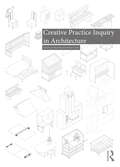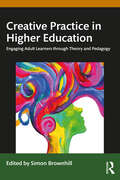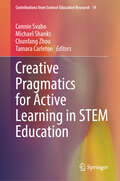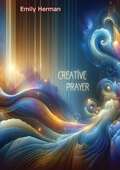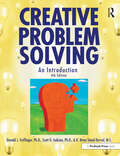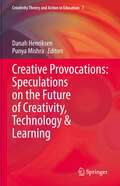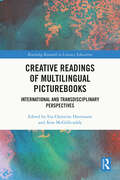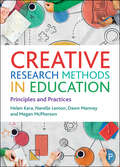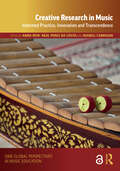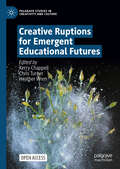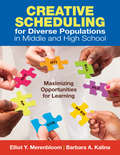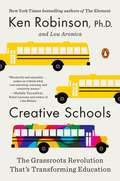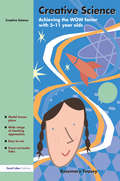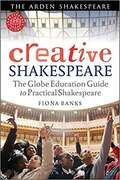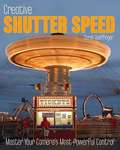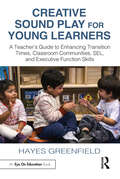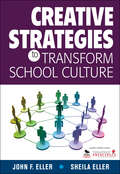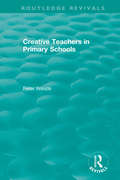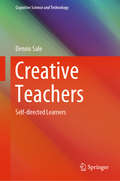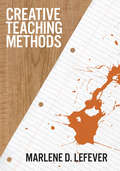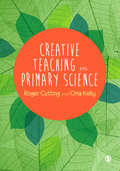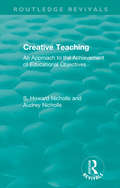- Table View
- List View
Creative Practice Inquiry in Architecture
by Adam Sharr Ashley MasonThis collection introduces, illustrates, and advances fresh ideas about creative practice inquiry in architecture. It concerns architectural knowledge: how architects can use their distinctive skills, habits, and values to advance professional insight, and how such insights can be extended to make wider contributions to society, culture, and scholarship. It shows how architectural ways of knowing and working can be mobilised as tools for research. Collected here are a series of creative practices that emerge out of architecture and actively engage with other fields and methods reaching across the academic landscape. Architectural inquiries collected in this book probe matters that lie beyond the obvious expectations, the conventions, the default, of the discipline. Drawing, borrowing, adapting, dramatising, perhapsing, monstering, experimenting, cartooning—the tools and methods of each inquiry vary but they all share a common outward gaze, engaging architectural ways of knowing with other disciplines and practices including the arts, biological sciences, ethnography, and technology. Chapters gathered here offer insight not only into incipient modes and tools of architectural research, but emerging ethical, practical, and philosophical positions intimately tied to the creative practices involved. Setting-out the idea of creative practice inquiry in architecture, this innovative volume offers a lively and resourceful contribution to a growing body of work on design as research. It will be of interest to: students keen to pursue architectural ways of thinking and writing; practitioners who want to use their distinctive professional abilities to contribute to architectural and scholarly knowledge; and academics and doctoral candidates keen to engage with the burgeoning scholarly field of design research.
Creative Practice in Higher Education: Engaging Adult Learners through Theory and Pedagogy
by Simon BrownhillThis must-read book considers the ways in which creativity can inspire new ideas, invigorate teaching in the adult learning space, and motivate professionals and learners alike. Written by a diverse group of international collaborators, this book empowers readers to embrace creative practices that are considered innovative, engaging, and impactful for adult learners at different levels.Drawing from a range of theoretical perspectives, contemporary research, and the lived experiences of the contributing authors, this edited volume offers readers a rich collection of pedagogical ideas and practical examples to apply within their professional practice. Chapters are divided into three key sections: Engaging experiences, such as large lectures, learning beyond the classroom, innovative technologies, and creative approaches to self-reflection. Engaging groups, including an exploration of communities within a range of educational, research, and geographical contexts. Engaging tools for learning, for example, poetry, digital portfolios, and innovations in providing feedback. An essential read for anyone working in adult education, this book highlights how practitioners may engage adult learners in creative ways within universities, with implications for further education and other adult education institutions.
Creative Pragmatics for Active Learning in STEM Education (Contributions from Science Education Research #14)
by Michael Shanks Tamara Carleton Connie Svabo Chunfang ZhouThis edited volume is an invitation to redesign STEM higher education. It shows the way to active learning in diverse scenarios and provides educators, leaders and policymakers with a visionary approach to active learning and hands-on examples of how education can help students navigate complexity and unpredictability—the challenges of contemporary society. Featuring contributions from a diverse array of scholars and practitioners, this book explores: · Creative learning strategies · Dynamic teacher-student interactions <span style="mso-bidi-font-size
Creative Prayer
by Emily HermanDiscover the transformative power of prayer with Emily Herman's Creative Prayer. This insightful and inspiring work explores the dynamic and creative aspects of prayer, offering readers a profound understanding of how prayer can be a vibrant and enriching part of their spiritual lives.Emily Herman, a respected author and spiritual teacher, delves into the essence of prayer, presenting it not just as a routine practice but as a powerful tool for personal and spiritual growth. In Creative Prayer, Herman encourages readers to explore prayer as a creative act that can deepen their connection with the divine, enhance their spiritual awareness, and bring about positive change in their lives.The book provides practical guidance on how to cultivate a more meaningful and engaging prayer life. Herman explores various forms of prayer, including contemplative, intercessory, and expressive prayers, and offers insights into how each type can be adapted to suit individual needs and circumstances. She emphasizes the importance of authenticity and spontaneity in prayer, encouraging readers to approach prayer with an open heart and a creative spirit.Creative Prayer also addresses common challenges and obstacles to effective prayer, providing strategies for overcoming distractions, doubts, and feelings of spiritual dryness. Herman’s compassionate and supportive approach helps readers navigate these challenges and find new ways to connect with the divine presence in their everyday lives.Rich with personal anecdotes, spiritual wisdom, and practical exercises, Creative Prayer is a valuable resource for anyone seeking to deepen their prayer practice and experience the transformative power of prayer. Whether you are new to prayer or looking to reinvigorate your existing practice, this book offers inspiration and guidance for making prayer a dynamic and life-enhancing part of your spiritual journey.
Creative Problem Solving in School Mathematics
by George LenchnerSolutions to part c Problems Some problem solving Strategies Some Topics in Problem Solving Solutions to Part a Problems Solutions to Part b Problems Teaching Problem Solving
Creative Problem Solving: An Introduction
by Donald J. Treffinger Scott G. Isaksen K. Brian Stead-DorvalCreative Problem Solving is a process that allows people to apply both creative and critical thinking to find solutions to everyday problems. Creative Problem Solving eliminates the tendency to approach problems in a haphazard manner and, consequently, prevents surprises and/or disappointment with the solution.Used by thousands of group leaders seeking a friendly introduction to using Creative Problem Solving, this book is a time-honored classic. Creative Problem Solving: An Introduction is based on more than five decades of extensive research, development, and field experience in educational settings, businesses, and many other organizations.Written for both group leaders and individuals seeking a systematic way to build innovative and effective solutions, Creative Problem Solving is perfect for any type of setting.This definitive guide shows you how to find successful solutions to important challenges. Creative Problem Solving (CPS) can help your students to approach problems and deal with change in a deliberate and constructive way, building their confidence and success in working with complex issues.This revised and updated fourth edition includes: easy-to-follow instructions for using Creative Problem Solving; practical tools for understanding the challenge, generating ideas, and preparing for action; expanded guidelines for planning your approach to Creative Problem Solving; strategies that ensure successful group dynamics; the latest trends in creative thinking and group problem solving; and practical suggestions for those new to Creative Problem Solving.Educational Resource
Creative Provocations: Speculations on the Future of Creativity, Technology & Learning (Creativity Theory and Action in Education #7)
by Danah Henriksen Punya MishraThis book explores the complex, yet critical, relationship between technology and creativity, specifically in educational contexts. Creativity is important for success in today’s rapidly changing, radically contingent and hyperconnected world. This is even more relevant in the context of teaching and learning—where the psychological, sociological and cultural aspects of human learning confront the challenges of a rapidly changing, technologically saturated world. Written by some of the foremost thinkers and researchers in the area of creativity and/or technology, the chapters in this volume examine the impact of recent and future technologies on creativity, teaching and learning. Individually and collectively, they help us develop an understanding of this nexus of creativity and technology for education. They offer new perspectives on this rapidly evolving future—exploring issues, paradoxes, tensions, and points of interest for creativity and technology. They position these issues in ways that consider implications for thinking, learning, teaching, and education in general.
Creative Readings of Multilingual Picturebooks: International and Transdisciplinary Perspectives (Routledge Research in Literacy Education)
by Áine McGillicuddy Esa Christine HartmannThis edited volume offers fresh perspectives on linguistic and cultural diversity in multilingual picturebooks, examining their potential to support multilingual learning in different educational contexts. Drawing on international, transdisciplinary perspectives from over fifteen countries, the book provides a comprehensive view of this unique literary genre.The collection showcases a wide range of languages featured in multilingual picturebooks, including Chinese, Farsi, Georgian, Irish, Korean, Malagasy, Mexican Indigenous languages, Mirandese, Northern Sámi, Portuguese, Spanish, Te Reo Māori, Ukrainian, and Welsh. Various chapters examine how multilingual picturebooks foster language and literacy development for emergent bilinguals in multilingual and multicultural environments, highlighting benefits such as linguistic and semiotic code-switching, as well as their ability to stimulate intercultural awareness in readers. The book also considers the creation, translation, and complex publishing processes of multilingual picturebooks, while exploring modern technologies such as eye tracking to analyse the reading processes of these books.Reflecting current insights and innovations in picturebook research, this volume will appeal to scholars, academics, and researchers in language and literacy education, multilingual education, and early childhood education. Those involved in children’s literature studies, multimodality, and bilingualism more broadly will also find this collection valuable.
Creative Research Methods in Education: Principles and Practices
by Helen Kara Narelle LemonCo-authored by an international team of experts across disciplines, this important book is one of the first to demonstrate the enormous benefit creative methods offer for education research. You do not have to be an artist to be creative, and the book encourages students, researchers and practitioners to discover and consider new ways to explore the field of education. It illustrates how using creative methods, such as poetic inquiry, comics, theatre and animation, can support learning and illuminate participation and engagement. Bridging academia and practice, the book offers: • practical advice and tips on how to use creative methods in education research; • numerous case studies from around the world providing real-life examples of creative research methods in education practice; • reflective discussion questions to support learning.
Creative Research in Music: Informed Practice, Innovation and Transcendence (ISME Series in Music Education)
by Anna Reid Jeanell Carrigan Costa, Neal Peres DaCreative Research in Music explores what it means to be an artistic researcher in music in the twenty-first century. The book delineates the myriad processes that underpin successful artistic research in music, providing best practice exemplars ranging from Western classical art to local indigenous traditions, and from small to large-scale, multi-media and cross-cultural work formats. Drawing on the richness of creative research work at key institutions in South-East Asia and Australian, this book examines the social, political, historical and cultural driving forces that spur and inspire excellence in creative research to extend and to cross boundaries, to sustain our music industry, to advocate for the importance of music in our world, and to make it clear that music matters.In the chapters, our authors present the ideas of informed practice, innovation and transcendence from diverse international perspectives. Each of these three themes has an introductory section where the theme is explored and the chapters in that section introduced. Taken as a whole, the book discusses how the themes in combination, with reference to the authorial group, are able to transform music pedagogy and performance for our global and complex world.Chapter 9 of this book is freely available as a downloadable Open Access PDF at http://www.taylorfrancis.com under a Creative Commons Attribution-Non Commercial-No Derivatives (CC-BY-NC-ND) 4.0 license.
Creative Ruptions for Emergent Educational Futures (Palgrave Studies in Creativity and Culture)
by Chris Turner Kerry Chappell Heather WrenThis open access book aims to show how creative ruptions – disturbances or commotions - can lead to the emergence of ethical, care-ful educational futures. Grounded in empirical and theoretical research undertaken from posthuman, decolonial, new materialist and feminist perspectives, this edited volume questions historical and current assumptions as to how education is structured and enacted, and provides examples and tools illustrating how to create and work with creative ruptions. Under the guidance of an experienced editorial team, the authors demonstrate how creative ruptions can respond to various wicked problems through the design and enactment of transformative pedagogies and accompanying research. Including consideration of how we can grow our emotional repertoires from anxiety to include hope and courage, the book explores how creativity might expand the horizons of personal, social and political possibility that take shape within – and ultimately determine – education and its futures.Offering theoretically driven and practically grounded transdisciplinary examples of alternative educational futures, this volume is an ideal reading for those interested in the intersecting fields of Possibilities Studies in Education, Creativity in Education, Educational Futures, Pedagogy, and related disciplines.
Creative Scheduling for Diverse Populations in Middle and High School: Maximizing Opportunities for Learning
by Elliot Y. Merenbloom Barbara A. KalinaDiverse needs, streamlined schedule—find out how with this all-in-one resource! How can each school day be inclusive for all learners, while making the most of limited time and resources? Help has arrived with this latest book from school-scheduling gurus Elliot Merenbloom and Barbara Kalina. You'll find: Best practices for program-specific scheduling, including RTI, credit recovery, special education, second language learning, career-technical education, work-study, Advanced Placement, and International Baccalaureate Guidance on scheduling that supports small learning communities, teacher collaboration, and other activities crucial to meeting diverse learning needs User-friendly templates and a professional development Q&A for every chapter
Creative Schools
by Lou Aronica Ken RobinsonA revolutionary reappraisal of how to educate our children and young people by Ken Robinson, the New York Times bestselling author of The Element and Finding Your Element Ken Robinson is one of the world's most influential voices in education, and his 2006 TED Talk on the subject is the most viewed in the organization's history. Now, the internationally recognized leader on creativity and human potential focuses on one of the most critical issues of our time: how to transform the nation's troubled educational system. At a time when standardized testing businesses are raking in huge profits, when many schools are struggling, and students and educators everywhere are suffering under the strain, Robinson points the way forward. He argues for an end to our outmoded industrial educational system and proposes a highly personalized, organic approach that draws on today's unprecedented technological and professional resources to engage all students, develop their love of learning, and enable them to face the real challenges of the twenty-first century. Filled with anecdotes, observations and recommendations from professionals on the front line of transformative education, case histories, and groundbreaking research--and written with Robinson's trademark wit and engaging style--Creative Schools will inspire teachers, parents, and policy makers alike to rethink the real nature and purpose of education.From the Hardcover edition.
Creative Schools: The Grassroots Revolution That's Transforming Education
by Lou Aronica Ken RobinsonA revolutionary reappraisal of how to educate our children and young people by Ken Robinson, the New York Times bestselling author of The Element and Finding Your Element Ken Robinson is one of the world's most influential voices in education, and his 2006 TED Talk on the subject is the most viewed in the organization's history. Now, the internationally recognized leader on creativity and human potential focuses on one of the most critical issues of our time: how to transform the nation's troubled educational system. At a time when standardized testing businesses are raking in huge profits, when many schools are struggling, and students and educators everywhere are suffering under the strain, Robinson points the way forward. He argues for an end to our outmoded industrial educational system and proposes a highly personalized, organic approach that draws on today's unprecedented technological and professional resources to engage all students, develop their love of learning, and enable them to face the real challenges of the twenty-first century. Filled with anecdotes, observations and recommendations from professionals on the front line of transformative education, case histories, and groundbreaking research--and written with Robinson's trademark wit and engaging style--Creative Schools will inspire teachers, parents, and policy makers alike to rethink the real nature and purpose of education.From the Hardcover edition.
Creative Science: Achieving the WOW Factor with 5-11 Year Olds
by Rosemary FeaseyThrough a refreshing blend of theory and practice this book provides stimulating material to develop creative approaches to science in the classroom. It includes: a range of teaching approaches that relate directly to the topic under discussion examples of pupils' work that portray how theory can be translated into practice quick off-the-shelf example model lesson plans which can be adapted. User-friendly and clearly laid out this book is a core text for primary teachers, NQTs and students who want to inject some creativity into their teaching and put that "WOW" factor back into their science lessons.
Creative Shakespeare: The Globe Education Guide to Practical Shakespeare
by Fiona BanksThis unique book desribes the ways in which educational practitioners at Shakespeare's Globe theatre bring Shakespeare to life for students of all ages.The Globe approach is always active and inclusive - each student finds their own way into Shakespeare - focusing on speaking, moving and performing rather than reading. <p><p>Drawing on her rich and varied experience as a teacher, Fiona Banks offers a range of examples and practical ideas teachers can take and adapt for their own lessons. The result is a stimulating and inspiring book for teachers of drama and English keen to enliven and enrich their students' experience of Shakespeare.
Creative Shutter Speed
by Derek DoeffingerA unique guide to creative shutter speed techniques, illustrated with striking full-color examplesAlong with available light and aperture, shutter speed is one of the variables that determine exposure-the amount of light that reaches the camera's sensor. Set on automatic modes, cameras typically attempt to reduce or eliminate blur in a picture. But by manipulating shutter speed creatively, photographers can achieve a range of striking motion blur or stop-action effects. Using an array of inspiring photographs depicting people, wildlife, and landscapes, Creative Power of Shutter Speed explains how to "read" the light and movement in a potential photograph and identify the best shutter speed for the desired effect.
Creative Sound Play for Young Learners: A Teacher’s Guide to Enhancing Transition Times, Classroom Communities, SEL, and Executive Function Skills
by Hayes GreenfieldThis fun and engaging guide invites you to use sound-making as a collaborative, play-based practice in your early childhood classroom—first to transform tricky transition times and ultimately to support your children’s executive functioning development and social-emotional learning. The book offers techniques and ideas for every teacher to reach every child in their classroom including verbal, nonverbal, and special needs children. Easy to integrate into all standard early years curricula, it focuses on three basic elements of sound: pitch, volume, and duration. The book features an "overview of the school year" calendar and an implementation guide, in addition to a variety of suggested sound-making activities that start out simply and, through the course of the book, expand to engage children’s creativity in more dynamic ways. Creative Sound Play for Young Learners is key reading for any preschool teacher, leader, or parent.
Creative Strategies to Transform School Culture
by John F. Eller Sheila A. EllerThe authors present practical, proven strategies to improve school culture, including activities for developing collaborative work relationships, dealing appropriately with conflict, and fostering rapport.
Creative Teachers in Primary Schools (Routledge Revivals)
by Peter WoodsIs creative teaching still possible in English schools? Can teachers maintain and promote their own interests and beliefs as well as deliver a prescribed National Curriculum? Originally published in 1995, this book explores creative teachers’ attempts to pursue their brand of teaching despite the changes. Peter Woods has discovered a range of strategies and adaptations to this end among such teachers, including resisting change which runs counter to their own values; appropriating the National Curriculum within their own ethos; enhancing their role through the use of others; and enriching their work through the National Curriculum to provide quality learning experiences. If all else fails, such teachers remove themselves from the system and take their creativity elsewhere. A strong theme of self-determination runs through these experiences. While acknowledging hard realities, the book is ultimately optimistic, and a tribute to the dedication and inspiration of primary teachers. The book makes an important contribution to educational theory, showing a range of responses to intensification as well as providing many detailed examples of collaborative research methods.
Creative Teachers: Self-directed Learners (Cognitive Science and Technology)
by Dennis SaleThis book offers teaching/training professionals an evidence-based pedagogic guide to teaching effectively, efficiently and creatively – also known as Creative Teaching Competence. Firstly it summarizes the extensive research on human psychological functioning relating to learning and how this can be fully utilized in the design and facilitation of quality learning experiences that maximize attainment and engagement opportunities. Secondly, it demonstrates what creativity actually ‘looks like’ in terms of specific teaching practices, modeling the underpinning processes (syntax) of creative learning design. It then establishes Metacognitive Capability as the superordinate twenty-first century competency; in that this unique human attribute can significantly enhance the cognitive and motivational strategies essential for facilitating self-directed learning and wellbeing. The book helps teaching/training professionals to thoughtfully apply evidence-based knowledge and strategies to today’s challenges, such as developing self-directed learners, enhancing intrinsic motivation, utilizing technology for learning and teaching, developing curricula for twenty-first century competencies and optimally framing and developing the heightened teacher expertise required today.
Creative Teaching Methods
by Marlene LefeverDo you ever wonder why Jeffrey talks all of the time?Or why Toni can't sit still? Or why Alex loves work sheets?Or why Jordan is always trying something new? Each chapter is fun to read, stimulating, and immensely practical. This book is valuable to teachers, and for preachers, too. DAVID R. MAINSDIRECTOR, CHAPEL OF THE AIR It's about time. Creative Teaching Methods is not just another book on the theory of creativity (which we don't need). Rather, it is a book on the practice of creativity in the classroom (which we desperately need). This is a book you will use over and over again.Creative Teaching Methods is loaded with practical and usable ideas that will make creative teaching a reality in your classroom. Without hesitation, I would recommend this book to anyone who teaches young people or adults. MIKE YACONELLIPRESIDENT, YOUTH SPECIALTIESMarlene LeFever makes the principle of learning through creative participation come alive for Christian education. Creative methods are vividly and invitingly explored for their potential for deepening the spiritual life through new ways of hearing the Word of God and using heretofore untapped personal resources in responding to it. Unique in its assumption that in Christian education creativity is just as essential in work with youth and adults as it is in work with children. D. CAMPBELL WYCKOFFPROFESSOR OF CHRISTIAN EDUCATION EMERITUS, PRINCETON THEOLOGICAL SEMINARY Marlene D. LeFever is Manager of Ministry Relations for David C. Cook Church Ministries, holds a master of Christian education and is a frequent speaker at Sunday School conventions, writers' conferences, and professional organizations. Editor of Teacher Touch, a quarterly letter of affirmation for Sunday School teachers, Marlene has authored over ten books, including Creative Teaching Methods (Cook), Creative Hospitality (Tyndale), and Is Your To Do List About To Do You In? (NavPress).
Creative Teaching in Primary Science
by Orla Kelly Dr Roger L. CuttingCreative teaching has the potential to inspire deep learning, using inventive activities and stimulating contexts that can capture the imagination of children. This book enables you to adopt a creative approach to the methods and content of your primary science teaching practice and confidently develop as a science educator. Key aspects of science teaching are discussed, including: planning for teaching and learning assessing primary science cross-curricular approaches the intelligent application of technology sustainability education outdoor learning Coverage is supported by illustrative examples, encouraging you to look at your own teaching practice, your local community and environment, your own interests and those of your children to deepen your understanding of what constitutes good science teaching in primary schools. This is essential reading for students on primary initial teacher education courses, on both university-based (BEd, BA with QTS, PGCE) and schools-based (School Direct, SCITT) routes into teaching. Dr Roger Cutting is an Associate Professor in Education at the Institute of Education at Plymouth University. Orla Kelly is a Lecturer in Social, Environmental and Scientific Education in the Church of Ireland College of Education.
Creative Teaching in Primary Science
by Roger Cutting Orla KellyCreative teaching has the potential to inspire deep learning, using inventive activities and stimulating contexts that can capture the imagination of children. This book enables you to adopt a creative approach to the methods and content of your primary science teaching practice and confidently develop as a science educator. Key aspects of science teaching are discussed, including: planning for teaching and learning assessing primary science cross-curricular approaches the intelligent application of technology sustainability education outdoor learning Coverage is supported by illustrative examples, encouraging you to look at your own teaching practice, your local community and environment, your own interests and those of your children to deepen your understanding of what constitutes good science teaching in primary schools. This is essential reading for students on primary initial teacher education courses, on both university-based (BEd, BA with QTS, PGCE) and schools-based (School Direct, SCITT) routes into teaching. Dr Roger Cutting is an Associate Professor in Education at the Institute of Education at Plymouth University. Orla Kelly is a Lecturer in Social, Environmental and Scientific Education in the Church of Ireland College of Education.
Creative Teaching: An Approach to the Achievement of Educational Objectives (Routledge Revivals)
by Audrey Nicholls S. Howard NichollsIn their highly successful practical guide, Developing a Curriculum, Howard and Audrey Nicholls provided a basic guide to curriculum planning for both practising and prospective teachers. In this second volume, originally published in 1975, some of the ideas outlined there at an elementary level are developed, with the aim of encouraging and guiding the development of ‘custom built’ curricula. Grasping the fundamental ideas and concepts of curriculum development is one problem for teachers, translating them into practice is another, and this book will go a long way to solving both problems. The development of justifiable and purposeful curricula for the particular pupils he is teaching is a primary task for any teacher, as is the modification of these curricula as circumstances and ideas change and the teacher forms his assessment of pupils’ needs and progress. The theoretical background to be taken into account when arriving at general curricular decisions is considered throughout, and groups, aids, organisation, records and assessment are all treated as essential items for the curriculum planner. Nor is the final problem, which the theorists often neglect, forgotten, namely that of implementing modifications or innovations once the curriculum has been created.
